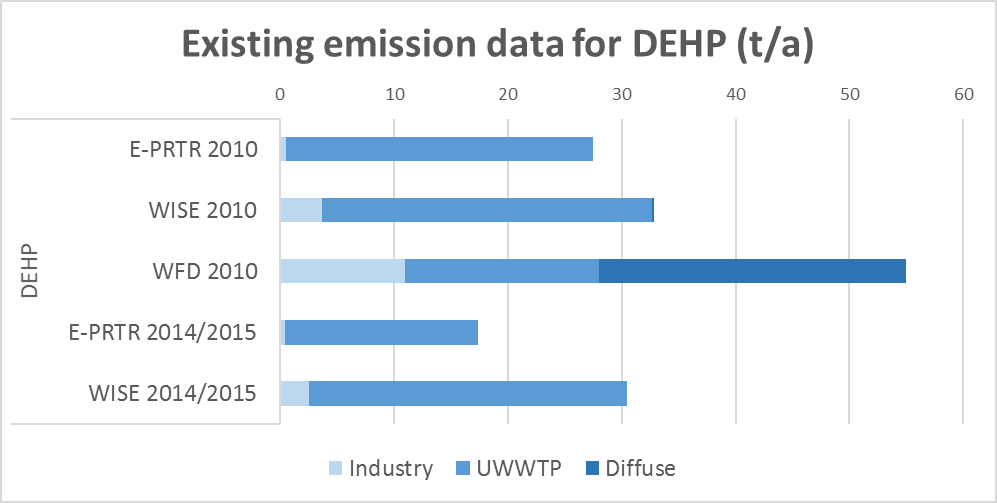Post a comment on the text below
3.5. Contamination from urban settlements
EEA’s RBMP Assessment showed that contamination from urban waste water treatment was the major point source of contamination of Europe’s surface waters. Note that in most cases treatment plants are recipients of contaminants from upstream uses and discharges, providing a known pathway into the aquatic environment, rather than they themselves being the user of hazardous substances.
Table 3.1b : List of pollutants most frequently exceeding EQS in EU25

(a) under the WFD EU-wide standards apply for priority substances (PS), while national or river basin standards apply for River Basin Specific Pollutants (RBSP).
(b) defined as priority hazardous substances, for which all discharges, emissions and losses must be ceased.
(c) Substance is ubiquitous, persistent, bioaccumulative and toxic (uPBT) as defined in 2013/39/EU.
3.2.1. Bis(2-ethylhexyl) phthalate (DEHP)
Sources and uses
DEHP is a widely-used phthalate, for example as a plasticizer in the manufacture of PVC. It has other uses, such as in hydraulic fluid, as a dielectric fluid in capacitors, sealing compounds in buildings and an additive in paints, cosmetics and biocides. Although its use is being phased out under REACH, DEHP’s widespread use in e.g. plastic water pipes represents a potential source to the environment for many years to come, owing to the long lifetime of those products.
Toxicity and EQS
DEHP is persistent in sediments and soils, but does not bioaccumulate in organisms. The main harmful effect is endocrine disruption to aquatic organisms, adversely affecting reproduction and growth.
WFD status
Despite its widespread use, DEHP caused failures in relatively few water bodies (table 3.1). This may be because it is relatively well removed by conventional waste water treatment, concentrating into the sludge (Gardner et al, 2014).
Emissions
Figure 3.6 gives an overview of the different reported loads.
Figure 3.6 : DEHP

About half the Member States, plus Norway, reported DEHP loads from industry and UWWTPs, showing that UWWTPs represent the most significant point source. There is a declining trend in reported loads from industry, while trends from UWWTPs are harder to assess owing to large fluctuations in some reported loads. Emissions of diffuse sources are difficult to compare owing to different approaches used by different countries and low levels of reporting. Important diffuse sources seem to be stormwater overflows and households not connected to the sewerage system.
Summary/Outlook
The major source of DEHP appears to be from UWWTPs, though diffuse sources may also be significant (Fig 3.6). Over time, the replacement of DEHP in plastics should lower the concentrations of DEHP reaching UWWTPs.
While it is hard to assess trends from the existing data, the decades-long lifetime of products containing DEHP would suggest that chemical status is unlikely to change much without significant effort to reduce emissions from the UWWTPs, whether that is at the plant itself or by preventing discharges into the sewerage system, e.g. through waste controls.
You cannot post comments to this consultation because you are not authenticated. Please log in.



Previous comments
DE-UBA IV 1.2:
DEHP is not a biocidal active substance. In which kind of biocidal products should DEHP be included and with which objective?
DENMARK
Danish monitoring results show that DEHP are discharged from all types of point sources (UWWTP, industry, combined sewer outlets, storm water overflows and scattered settlements). The monitoring results do not suffice to draw conclusions on a possible development in discharges (http://dce2.au.dk/pub/SR142.pdf).
EurEau
The first paragraph of section 3.5 is crucial in addressing the role of WWTP in pollution emissions. It is important to make sure that the role of pathways is understood through out the text, which is not the case at the moment.
Not all problem will be solved by increasing the level of treatment of WWTP. Sustainability of treatment will require investment in upstream control at source measures.